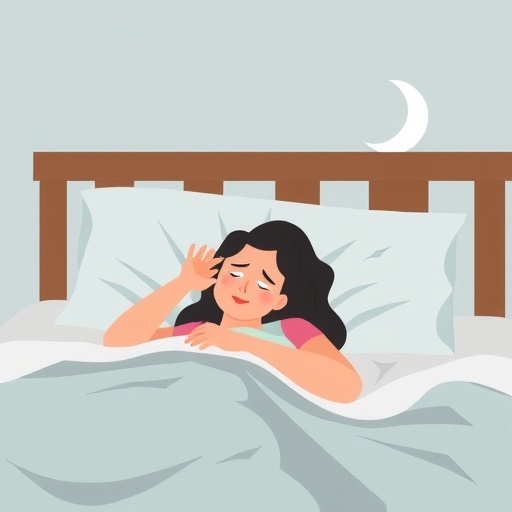Premenstrual syndrome (PMS) represents a complex psychiatric and neurological condition that impacts a majority of menstruating individuals worldwide. While the fluctuating hormonal levels during the menstrual cycle have long been implicated, recent pioneering research sheds light on an underappreciated but vital contributor to the neuropsychiatric symptoms of PMS: sleep quality. A groundbreaking study published in BMC Psychiatry has now elucidated the intricate connections between sleep disturbances, brain network dysfunctions, and anxiety-depression symptoms, offering new avenues for targeted therapeutic interventions.
The investigation focused on the default mode network (DMN), a critical constellation of brain regions known to be active during resting states and involved in self-referential thinking, emotional regulation, and mood stability. Dysregulated functional connectivity within the DMN has previously been associated with mood disorders such as anxiety and depression, which are hallmark features exacerbated in PMS. However, prior studies largely overlooked how sleep quality influences these neural dynamics, leaving a knowledge gap in the pathophysiology of PMS.
To bridge this gap, researchers recruited 77 women diagnosed with PMS along with 66 healthy control participants, ensuring well-matched cohorts. Participants underwent resting-state functional magnetic resonance imaging (fMRI) to map brain activity patterns without task engagement. Concurrently, validated clinical scales assessed sleep quality using the Pittsburgh Sleep Quality Index (PSQI), and psychological symptoms via the Self-Rating Anxiety and Depression Scales. This multimodal design allowed for a comprehensive examination of how sleep interfaces with brain connectivity and clinical manifestations in PMS.
Crucially, based on their PSQI scores, the PMS group was stratified into those with normal sleep quality (PMS-NSQ) and those reporting poor sleep quality (PMS-PSQ). This stratification enabled the dissection of sleep-dependent alterations in DMN connectivity. Both PMS subgroups exhibited increased resting-state functional connectivity between the left inferior parietal lobule (IPL) and right middle occipital gyrus relative to healthy controls, suggesting a shared neural signature of PMS independent of sleep disturbances.
More strikingly, in the PMS-NSQ group, researchers observed decreased functional connectivity between the right ventromedial prefrontal cortex (VMPFC) and the right posterior cingulate cortex/precuneus (PCu), core hubs within the DMN. Additionally, this group demonstrated reduced degree centrality of the right VMPFC, indicating diminished influence and integration within the network. These findings implicate the VMPFC-PCu axis as a neurobiological substrate linked to PMS symptomatology, particularly when sleep is not overtly compromised.
Perhaps most illuminating were the correlation and mediation analyses revealing that sleep quality mediates the relationship between altered VMPFC-PCu connectivity and the severity of anxiety and depression in PMS patients. In other words, poor sleep exacerbates the dysfunctional communication within the DMN, which in turn intensifies psychological symptoms. This pivotal insight positions sleep disturbances not merely as a symptom, but as an active modulatory factor in the neuropsychiatric dynamics of PMS.
From a neurophysiological perspective, the VMPFC is extensively involved in emotional regulation, decision-making, and processing of internally generated thoughts, whereas the PCu is crucial for self-related mental activities and consciousness. Disrupted connectivity between these regions can foster maladaptive rumination and heightened anxiety-depression states. Sleep deprivation or poor sleep quality could potentiate these disruptions by impairing synaptic homeostasis and altering neurotransmitter systems such as serotonin and GABA, which are vital for mood stabilization.
These findings bear profound clinical implications. Targeting sleep quality through behavioral, pharmacological, or neuromodulatory interventions could ameliorate the underlying neurofunctional abnormalities within the DMN, thereby reducing anxiety-depression symptoms in PMS. The right VMPFC emerges as a promising candidate for such strategies, potentially via transcranial magnetic stimulation or neurofeedback paradigms aimed at restoring effective connectivity.
Furthermore, the study highlights the necessity of considering sleep parameters in future neuroimaging investigations of PMS and related mood disorders. Ignoring the influence of sleep quality could mask the true extent and nature of brain network dysfunctions, leading to incomplete or misleading conclusions. This research advocates for an integrated framework encompassing hormonal, neural, and sleep dimensions to fully capture the complexity of PMS pathogenesis.
The use of resting-state fMRI in this context underscores the utility of non-invasive imaging techniques to unravel the subtle, yet impactful, cerebral connectivity changes associated with neuropsychiatric disorders. By coupling functional imaging with rigorous psychometric assessments, the study exemplifies a precision medicine approach that aligns biological markers with clinical phenotypes.
It is noteworthy that the research was rigorously registered and conducted under stringent ethical guidelines, bolstering the validity and reproducibility of the findings. However, future studies could expand on these results by incorporating longitudinal designs to track the temporal dynamics of sleep and DMN connectivity across menstrual cycles, providing even richer insights into causal mechanisms.
In conclusion, this seminal work establishes sleep quality as a critical mediator of brain network alterations affecting anxiety and depression in PMS. It transforms our conceptualization of PMS from solely hormone-driven to an integrated neurobehavioral syndrome influenced by sleep health. Embracing this paradigm may revolutionize treatment approaches, enhancing quality of life for millions grappling with the debilitating psychological symptoms of PMS.
As neuroscience continues to deepen our understanding of brain-behavior relationships, this study stands out for its innovative linking of sleep, functional neuroimaging, and psychiatric symptomatology. The right ventromedial prefrontal cortex emerges as a neuroanatomical linchpin whose functional status reflects and potentially dictates the clinical trajectory in PMS, mediated by sleep disturbances. Addressing these neurofunctional targets may herald a new era in psycho-neuroendocrinology and personalized care for menstrual-related mood disorders.
Subject of Research: The impact of sleep quality on default mode network functional connectivity and anxiety-depression symptoms in premenstrual syndrome (PMS).
Article Title: Effects of sleep quality on the default mode network and on anxiety-depression symptoms in premenstrual syndrome
Article References:
Qin, H., Zhang, Y., Li, S. et al. Effects of sleep quality on the default mode network and on anxiety-depression symptoms in premenstrual syndrome. BMC Psychiatry 25, 1047 (2025). https://doi.org/10.1186/s12888-025-07126-2
Image Credits: AI Generated
DOI: 03 November 2025




